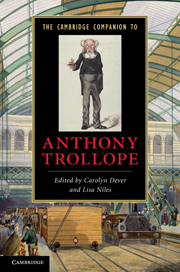Book contents
- Frontmatter
- Introduction
- 1 Trollope’s Literary Life and Times
- 2 Trollope As Autobiographer And Biographer
- 3 Trollope’s Barsetshire Series
- 4 The Palliser Novels
- 5 Trollope Redux: The Later Novels
- 6 Trollope’s Short Fiction
- 7 Trollope And The Sensation Novel
- 8 Queer Trollope
- 9 The hobbledehoy in Trollope
- 10 The construction of masculinities
- 11 Vulgarity and money
- 12 Trollope and the law
- 13 Trollope and travel
- 14 Trollope and the Antipodes
- 15 Trollope and Ireland
- 16 Trollope and America
- Further reading
- Index
- Cambridge Companions to . . .
1 - Trollope’s Literary Life and Times
Published online by Cambridge University Press: 28 March 2011
- Frontmatter
- Introduction
- 1 Trollope’s Literary Life and Times
- 2 Trollope As Autobiographer And Biographer
- 3 Trollope’s Barsetshire Series
- 4 The Palliser Novels
- 5 Trollope Redux: The Later Novels
- 6 Trollope’s Short Fiction
- 7 Trollope And The Sensation Novel
- 8 Queer Trollope
- 9 The hobbledehoy in Trollope
- 10 The construction of masculinities
- 11 Vulgarity and money
- 12 Trollope and the law
- 13 Trollope and travel
- 14 Trollope and the Antipodes
- 15 Trollope and Ireland
- 16 Trollope and America
- Further reading
- Index
- Cambridge Companions to . . .
Summary
Anthony Trollope is well known as one of the most prolific and energetic of Victorian novelists. Forty-seven novels, four lengthy travel books, four biographical studies, five collections of short stories, three collections of non-fiction sketches, a range of journalism – this would be an impressive output for any writer over a lifetime, but it is perhaps more striking because Trollope did not publish his first book until 1847 at the age of thirty-two. By this time he had already established himself as a rising civil servant in the General Post Office, having gradually worked his way up from a junior clerk in London, to surveyor’s clerk in Ireland, and finally to a surveyor and inspector himself; he remained devoted to the civil service job until 1867, when he resigned, with a view to entering Parliament. But Trollope’s professional life was not always so smooth; according to An Autobiography, it was the move to Ireland at the age of twenty-four that was the making of the man and which saved him from an aimless, unambitious London life. As a studious inspector of postal routes in Ireland, he would follow in the footsteps of postal deliverers, seeking to find ways to improve speed of delivery and generally improve service. Among his notable achievements in the Post Office was his role in developing the first pillar box for the collection of post. So, Trollope had a double professional life – as career civil servant and then as popular writer – and these professions ran parallel for nearly twenty years and mutually informed each other. As a local and global traveler often engaged in government and colonial business, and as a writer whose works were widely disseminated and reprinted, Trollope is a particularly interesting figure who sheds light on the shifting and complex literary marketplace in the middle of the nineteenth century.
- Type
- Chapter
- Information
- The Cambridge Companion to Anthony Trollope , pp. 6 - 16Publisher: Cambridge University PressPrint publication year: 2010

